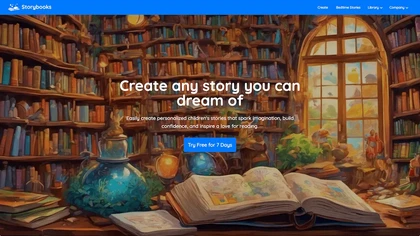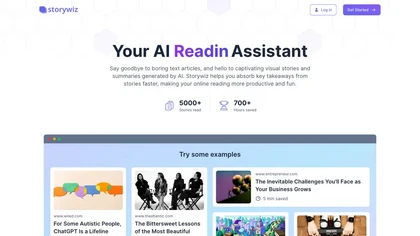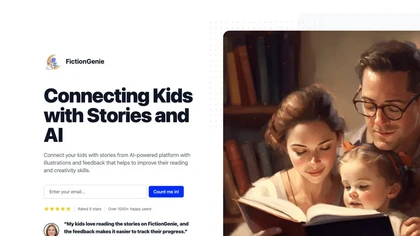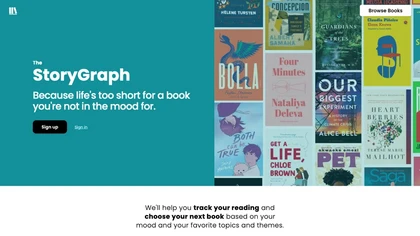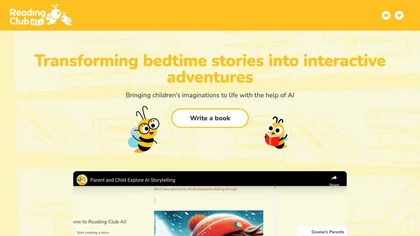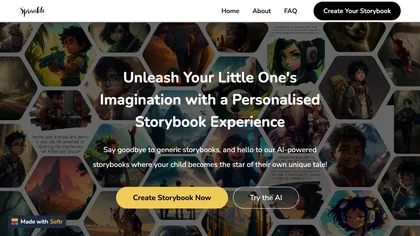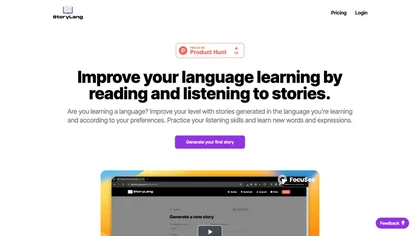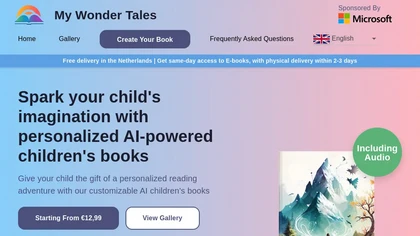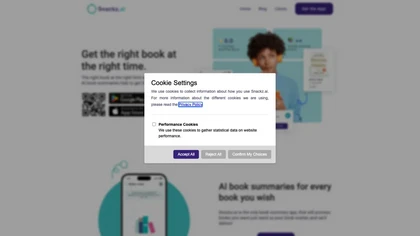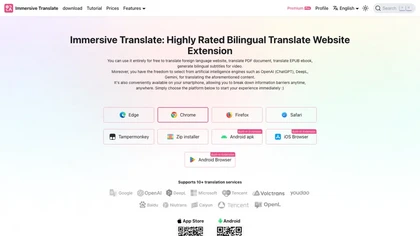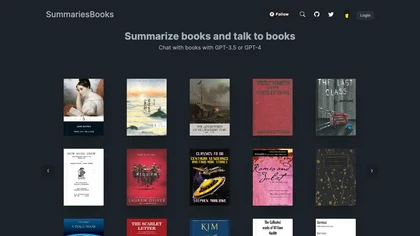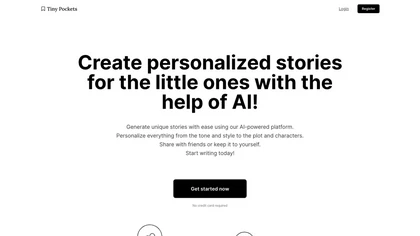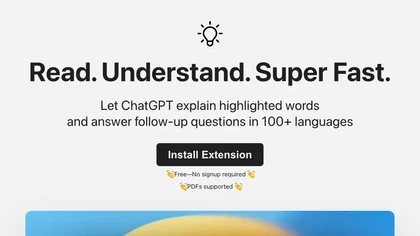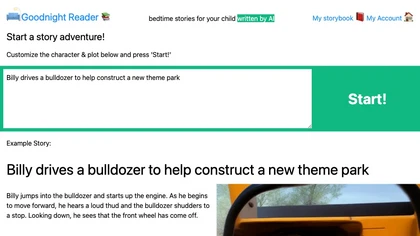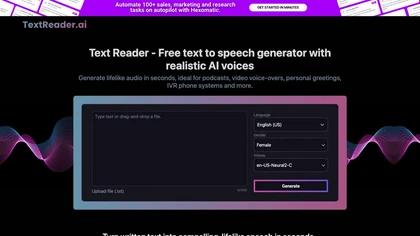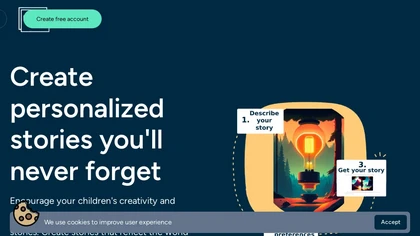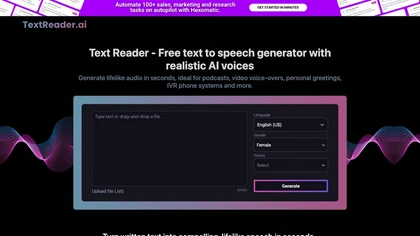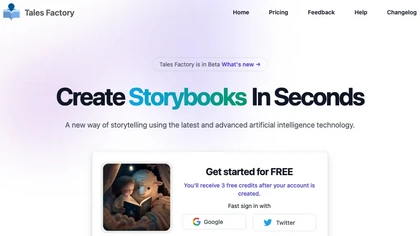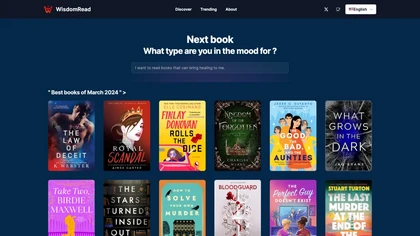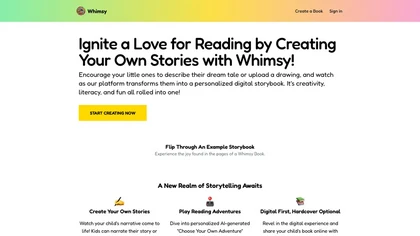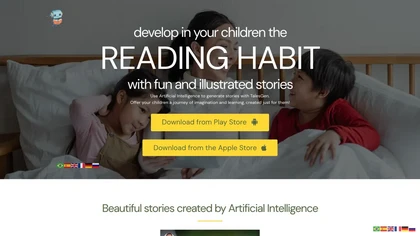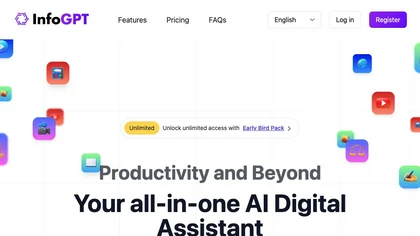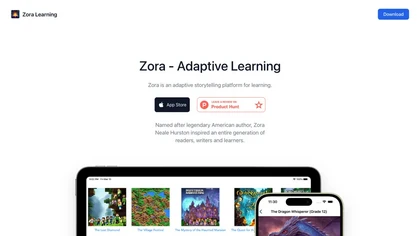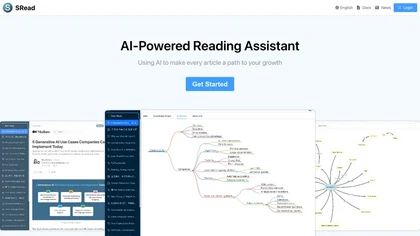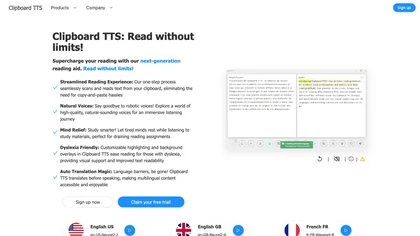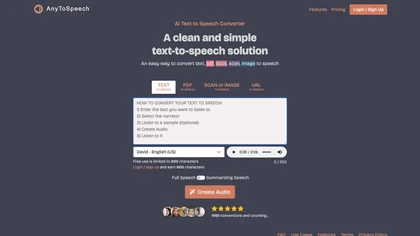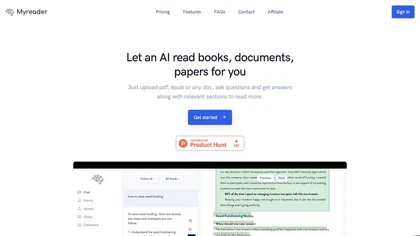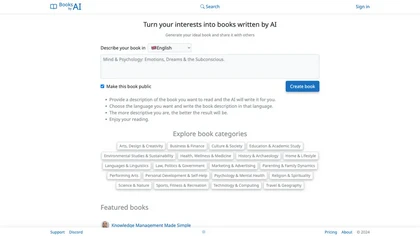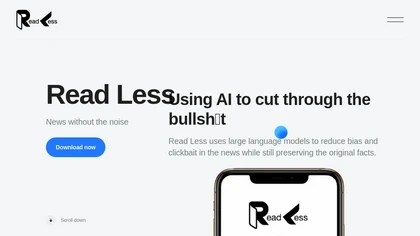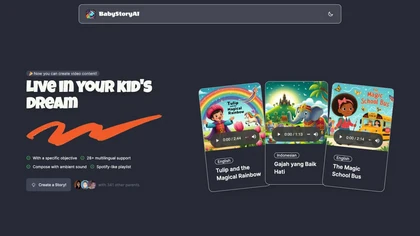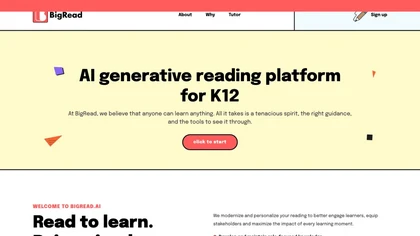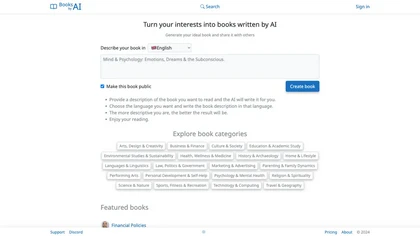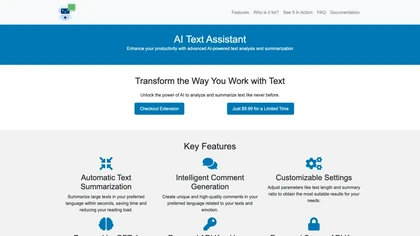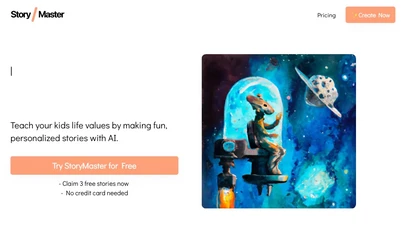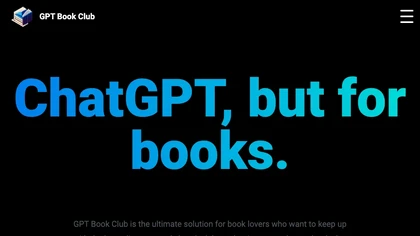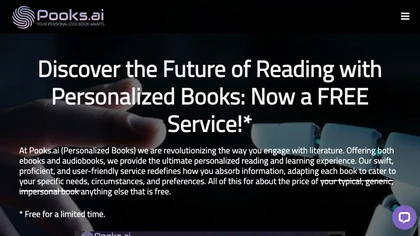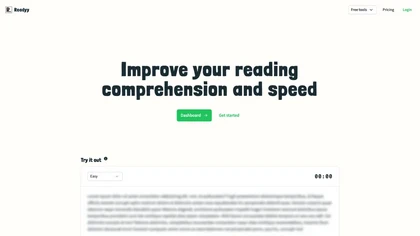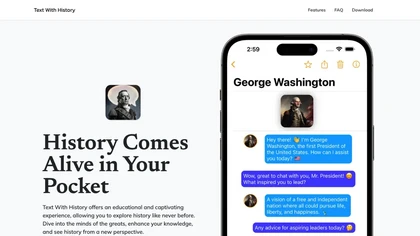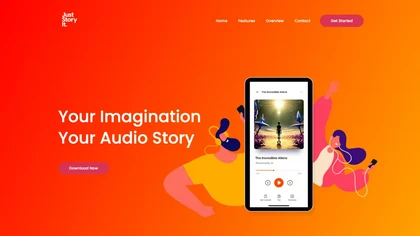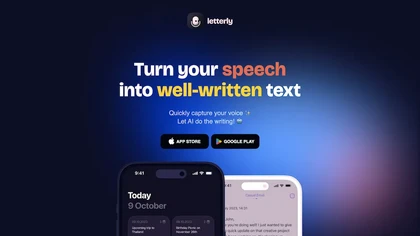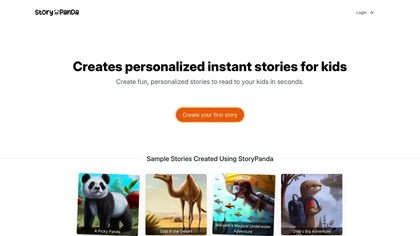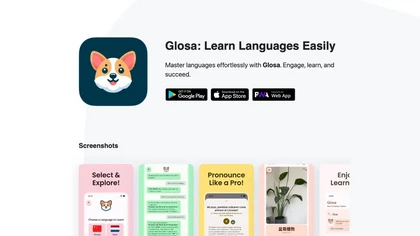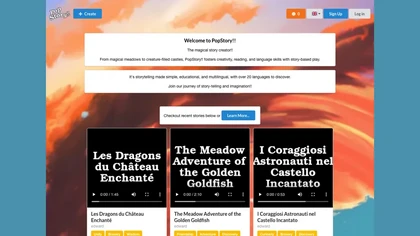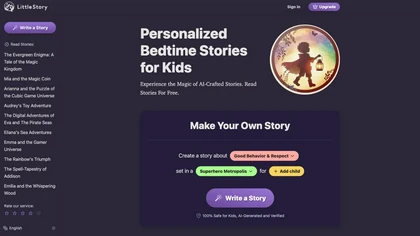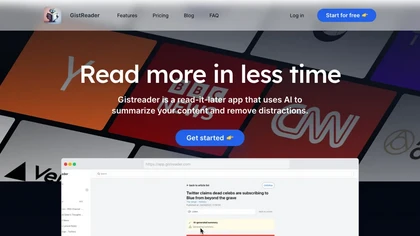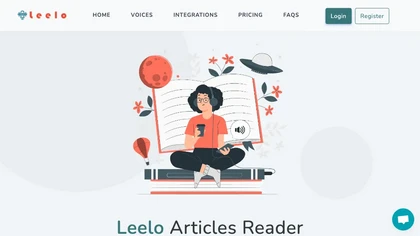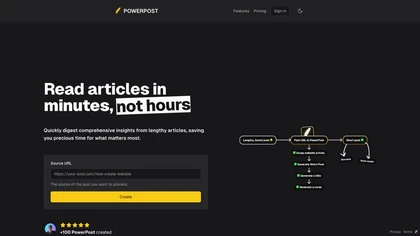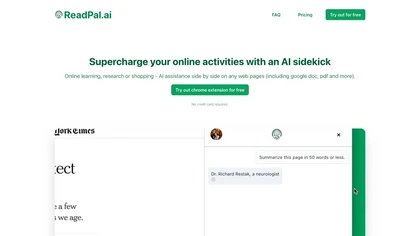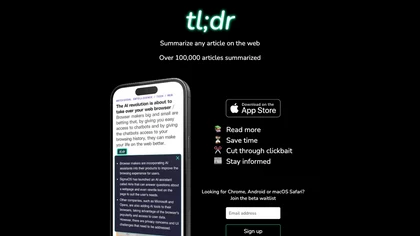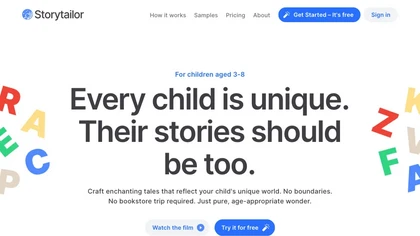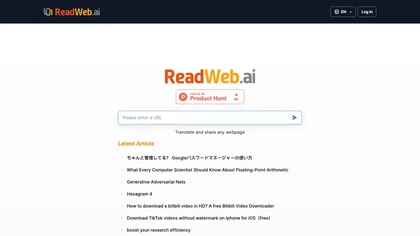AI use cases for Digital reading
Generative AI can be applied in various applications for digital reading. Here are some examples to explore below for inspiration with AI tools to get you started with using AI in digital reading.
🛠️ 70 AI tools for Digital reading
Explore a dynamic list of some of the most popular tools to get you started with various AI use cases and applications for Digital reading to streamline your workflows and productivity today.
StoryBooks features
- Customize characters
- Tailor story to preferences
- Create personalized experience
- Support story generation in multiple languages
- Promote linguistic inclusivity
StoryWiz features
- Transforms text articles into visual stories
- Generates concise AI-powered summaries
- Offers thousands of unique designs for visual stories
- Provides personalized story feed based on individual interests
- Enhances reading productivity and learning efficiency
FicitonGenie features
- Personalized feedback based on reading and creativity skills
- Multi-lingual book adventure feature for exploring different languages and cultures
- Tailored AI profiles based on child's age and language preferences
- Narration options in preferred language for promoting learning and vocabulary expansion
- AI-powered feedback system for tracking and enhancing creativity and storytelling passion
The StoryGraph features
- Intuitive tracking features
- Insightful stats
- Personalized recommendations powered by machine learning AI
- Customize book selection based on mood, topics, and themes using filters
- Add live reactions without spoilers while reading with friends
Readingclub features
- Transform bedtime stories into interactive adventures
- write books
- Ability to illustrate, edit prompts, and change images
- Support for multiple languages.
Sprinkle features
- Story generation
- Personalization
- Unique tales
- Adventure
- Ai technology
StoryLang features
- Customizable story generation
- Text and audio output
- Vocabulary expansion
- Personalized enhancements using OpenAI API
- Credit-based story generation
🔥
Create your account, save tools & get personal recommendations
Receive a weekly digest of our handpicked top tools.
Unsubscribe anytime
My Wonder Tales features
- Character customization
- Story personalization
- Genre selection
- Audiobook customization
- Device compatibility
SnackzAI features
- AI-powered book summary tool
- Provides book summaries in text and audio formats
- Diverse library covering various genres and topics
- Allows users to request their preferred voice for audio summaries
- Partners with authors and publishers
Immersive Translate features
- Translate foreign language websites
- Translate PDF documents
- Translate ePub ebooks
- Support for multiple artificial intelligence engines like ChatGPT and DeepL
- Innovative segment-by-segment translation mode
Find Your Next Book features
- Personalized book recommendations
- Analyze reader preferences and interests
- Suggest books based on genre, author and other criteria
- Include ratings and reviews from other readers
summariesbooks features
- GPT-3.5 and GPT-4 integration
- Book summaries generation
- Mind map generation
- Online book reading
- Chat feature for interacting with a book robot
Tiny Pockets features
- Personalized story generation
- Customization of tones, styles, plots, and characters
- Multi-language support
- Collaborative story creation
- Export stories in PDF format
Childbook features
- Create customizable stories
- Generate original characters
- Add illustrations
- Customize plots
- Text-to-speech
Tooltips AI features
- Text reading
- Text understanding
- Language support
- Free extension
- Pdf support
Mi Cuento Digital features
- Customizable storytelling
- Personalized tale generation
- Education through stories
- Illustrated pages
- Family-friendly reading experience
helloello.com features
- Adaptive learn™ technology
- Personalized reading experience
- Proprietary AI engine
- Exclusive decodable e-books
- Reading coach app
Goodnightreader features
- Character creation
- Plot customization
- Example stories
- Free version
- Feedback
Text Reader features
- Text-to-speech generation
- Realistic AI voices
- High-fidelity WaveNet voices
- Download voice audio in mp3 format
- Multilingual natural voices
Clearly Reader features
- Advanced text-to-speech features
- Reader mode for focused content consumption
- Cloud clipping capabilities
- Adjustable themes, fonts, sizes, and colors
- Quick translations
Tinytales features
- Customized story creation
- Protagonist appearance customization
- Illustration style customization
- Narration customization
- Dialogue customization
Text Reader AI features
- Text-to-Speech Generation
- High-fidelity WaveNet voices
- Download audio in MP3 format
- Support for over 40 languages
- Versatile use for personal and commercial projects
Infinite Pages features
- Creates interactive picture books
- Personalizes main characters using AI
- Generates engaging stories
- Illustrates and writes stories using AI
- Showcases the power of AI in storytelling
Tales Factory
3.4Tales Factory features
- Generate unique and coherent stories
- Provide custom illustrations
- Voiceovers
- Various genres
- Publish and share storybooks
WisdomRead features
- Personalized book recommendations
- Matching books to current mood
- Wide array of book genres
- Recommendations for specific time periods
- Transmuting words into wisdom
WhimsyWorks features
- AI-powered story creation for kids
- Transformation of children's descriptions and drawings into personalized digital storybooks
- Interactive AI-generated games for reading adventures
- Age-appropriate and personalized storytelling experiences
- Option for digital or physical hardcover versions of storybooks
TalesGen features
- Generates personalized stories for children in multiple languages
- Offers a wide range of genres, themes, and complexity levels to choose from
- Creates age-appropriate content to spark children's imagination and love for reading
- Features AI-generated illustrations for visually captivating stories
- Ensures all content is safe, wholesome, and educational for kids
Beeyond AI features
- Voice-to-text conversion
- Art studio functionality
- Pdf document chatbot
- Social media optimization
- Travel planning assistance
- Nutritional recipe creation
- Book and movie research
- Productivity tools
- Legal assistance
- Multilingual support
- Organization and content categorization
- Up-to-date information access
BooksAI features
- Over 40 million book summaries
- Support for 9 languages
- AI-powered generation of concise and spoiler-free synopses
- Book recommendations based on user preferences
- Creation of digital reading lists
Zora Learning features
- Adaptive storytelling platform
- User control for creating characters and exploring genres
- Personalization features for customizing characters, plots, and themes
- Stories that adapt and grow with the reader's skill level
- Gamification for earning rewards and enhancing vocabulary comprehension
SRead features
- Chat with online articles
- Chat with document files (PDFs, DOCX, PPTX)
- Chrome extension for chatting directly in the browser
- Mind map summary feature
- Knowledge graph feature
Purrbook features
- Reading
- Speaking
- Language learning
- Interactive
- Captivating storytelling
Clipboard TTS features
- Clipboard scanning
- Text-to-Speech functionality
- High-quality natural voices
- Dyslexia-friendly features
- Auto-translation capabilities
Rory features
- Generate
- Personalized
- Bedtime
- Stories
Myreader AI features
- Upload and read books, documents, and papers in various formats
- Ask questions related to uploaded content and receive accurate answers
- Explore answers based on content of the materials
- Jump to the exact page in the book to find information
- Cloud storage for documents and ability to upload different file types
Books by AI features
- Book generation
- Tailored descriptions based on user interests
- Language selection for enhanced results
- Covering a wide range of book categories
- Support for both personal and academic purposes
Readless.ai features
- Renders news in multiple languages
- Pulls from a network of reputable publishers
- Condenses stories into bite-sized or bulleted summaries
- Effectively counters bias, clickbait, and information overload
- Tailors news feed to user preferences
BabyStoryAI features
- Personalized video content creation
- Support for over 28 languages
- Ambient sound and playlists
- Custom music and voices
- Upcoming interactive elements
BigRead.ai features
- Generative reading plans
- Adaptive technology
- Standards-aligned exercises
- Detailed learning reports
- Interactive reading exercises
books-by-ai.com features
- Generate book descriptions based on user interests
- Create and share book descriptions in multiple languages
- Wide range of book categories to explore
- Ensures descriptive and personalized book descriptions
- Improves reading experience
AI Text Assistant features
- Text summarization in preferred language
- Utilizes GPT-4 technology from OpenAI
- Automatic comment generation
- Customizable settings for text length and summary ratio
- Applicable to various user types: content creators, writers, students, academics, marketers, journalists, business analysts, educators, and teachers
MicroMusic features
- Web-based tool
- Text summarization
- Key information extraction
- Natural language processing techniques
- Reading and research process optimization
Talefy features
- Interactive freedom
- Personalized scenarios
- Illustrated Narratives
- Immersive experience
- Diverse range of stories
- Gameplay enhancements
Wendy StoryTeller features
- Personalized illustrated audio stories
- On-the-fly story generation
- Available on iOS, Android, and web
- Utilizes AI for audio generation support
- Provides unique storytelling experience
StoryMaster features
- Genre discovery
- Multilingual reading
- Exclusive illustrations
- Enhancing reading and writing skills
- Strengthening parent-child bonding
GPT Book Club features
- Search
- Read
- Answer
- Interact
- Catalog
Pooks features
- Create personalized ebooks
- Create personalized audiobooks
- Personalized reading experience
- Tailed to specific needs and preferences
- Free limited time offer
Readyy features
- Enhances reading speed and comprehension
- User-friendly dashboard for easy usage
- Tracks progress and analyzes reading attempts
- Utilizes GPT-powered AI technology
- Incorporates gamification elements for engagement
StoriesForKids.ai: Personalized Kid's Books using AI features
- Generate stories
- Create illustrations
- Promote reading and creativity
- Suitable for real-life situations
- Available on mobile devices
Text With History features
- Engaging conversations with famous historical figures
- Support for over 100 languages
- Ability to share conversations with friends
- Accurate responses based on publicly available data
- Wide range of historical figures available for chat
Just Story It features
- Customizable creation of audio stories
- Option to choose characters, environments, genres, and durations
- AI technology for generating audio stories
- Providing cover images for the audio stories
- Access to Discovery Stories library
TaleWeaver features
- Personalized storybook creation
- Safety features including profanity and mature themes filtering
- Customization options for parents to tailor stories based on child's preferences
- Age-appropriate vocabulary selection
- Illustrations to stimulate a child's imagination
Letterly.app features
- Speech-to-Text Transcription
- Multi-language Support
- Powerful AI Writing Enhancement
- Voice Recording with Rewrite Options
StoryPanda.ai features
- Allows kids to create personalized instant stories
- Provides simple prompts to kick-start the creative process
- Offers different reading levels for stories
- Allows customization of art styles
- Generates stories with the child's name and family members as characters
Dreamstories features
- Personalized story creation
- Content skipping for social media sharing
- Limited launch offer
- Customizable country/region options
- Ability to feature loved ones as heroes
Glosa features
- Personalized learning experience
- Adapts to user style, pace, and preferences
- Mobile-optimized platform
- Track progress visually
- Extensive selection of languages
PopStory!! features
- Story creation using magical themes
- Platform for fostering creativity and language skills
- User-friendly interface for simple storytelling
- Support for multiple languages (20 different languages)
- Immerse users in imaginative storytelling journey
LittleStory.io features
- Personalized bedtime stories
- Safety-focused content review
- Co-creation with superhero themes
- Open discussions on sensitive topics
- Advanced customization options
GistReader features
- Transform articles into clean and readable format
- Automatic AI article summarization
- Support for single page articles and RSS feeds
- Cross-device synchronization of content and preferences
- Additional features: Keyboard shortcuts, Pocket integration, YouTube support, OPML import, Dark mode, No ads
Narrator: Audiobook Maker features
- Free audio text reader
- Support for multiple formats
- Adjustable reading speeds
- Ability to create and convert audiobooks
- Save and share created audiobooks
Depth Tale features
- AI-assisted choose adventure builder
- Tailored storytelling with interactive visualization
- Dynamic narrative sculpting based on user choices
- Customizable visuals for characters and environments
- Immersive audio, 3D visuals, and dynamic voiceovers
Leelo features
- Text-to-speech conversion
- Customizable languages and accents
- Cloud storage for generated speech files
- Embeddable widget on websites
- Dashboard for monitoring usage and quota
PowerPost features
- Article summarization
- Integrated chat function
- Multilingual translation
- Customizable reading experience
- User-friendly interface
lingoXpress features
- Comprehensive language learning tool
- Accessible on Kindle and smartphones
- Wide array of resources including books, audio content, daily word features
- AI tutor for personalized learning
- Support for over 65 languages, including constructed languages like Klingon and Dothraki
ReadPal features
- Instant explanations
- Summaries
- Recommendations
- Deeper insights
- Integration into workflow
tl;dr AI Summarizer features
- Web article summarization
- Ability to summarize over 100,000 articles
- Support for Chrome, Android, macOS, and Safari
- Beta waitlist access
- Streamlining reading experience
AIby.email features
- Text generation
- Grammar correction
- Summarization
- Custom story generation for children
- Study plan creation
Storytailor features
- AI-powered story generation
- Customizable stories based on reader's taste
- Personalized storytelling for every stage of a child's growth
- Bespoke artwork and engaging activities with each story
- Naturalized voiceover AI to read stories coming soon
ReadWeb.ai features
- Multi-language web page translation
- Instant translation experience
- Simultaneous comparison of two languages
- Translation of individual pages or entire websites
- Easy content sharing
